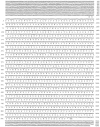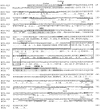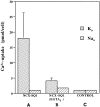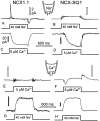Cloning, expression, and characterization of the squid Na+-Ca2+ exchanger (NCX-SQ1)
- PMID: 9607941
- PMCID: PMC2217150
- DOI: 10.1085/jgp.111.6.857
Cloning, expression, and characterization of the squid Na+-Ca2+ exchanger (NCX-SQ1)
Abstract
We have cloned the squid neuronal Na+-Ca2+ exchanger, NCX-SQ1, expressed it in Xenopus oocytes, and characterized its regulatory and ion transport properties in giant excised membrane patches. The squid exchanger shows 58% identity with the canine Na+-Ca2+ exchanger (NCX1.1). Regions determined to be of functional importance in NCX1 are well conserved. Unique among exchanger sequences to date, NCX-SQ1 has a potential protein kinase C phosphorylation site (threonine 184) between transmembrane segments 3 and 4 and a tyrosine kinase site in the Ca2+ binding region (tyrosine 462). There is a deletion of 47 amino acids in the large intracellular loop of NCX-SQ1 in comparison with NCX1. Similar to NCX1, expression of NCX-SQ1 in Xenopus oocytes induced cytoplasmic Na+-dependent 45Ca2+ uptake; the uptake was inhibited by injection of Ca2+ chelators. In giant excised membrane patches, the NCX-SQ1 outward exchange current showed Na+-dependent inactivation, secondary activation by cytoplasmic Ca2+, and activation by chymotrypsin. The NCX-SQ1 exchange current was strongly stimulated by both ATP and the ATP-thioester, ATP gamma S, in the presence of F- (0.2 mM) and vanadate (50 microM), and both effects reversed on application of a phosphatidylinositol-4',5'-bisphosphate antibody. NCX1 current was stimulated by ATP, but not by ATP gamma S. Like NCX1 current, NCX-SQ1 current was strongly stimulated by phosphatidylinositol-4',5'-bisphosphate liposomes. In contrast to results in squid axon, NCX-SQ1 was not stimulated by phosphoarginine (5-10 mM). After chymotrypsin treatment, both the outward and inward NCX-SQ1 exchange currents were more strongly voltage dependent than NCX1 currents. Ion concentration jump experiments were performed to estimate the relative electrogenicity of Na+ and Ca2+ transport reactions. Outward current transients associated with Na+ extrusion were much smaller for NCX-SQ1 than NCX1, and inward current transients associated with Ca2+ extrusion were much larger. For NCX-SQ1, charge movements of Ca2+ transport could be defined in voltage jump experiments with a low cytoplasmic Ca2+ (2 microM) in the presence of high extracellular Ca2+ (4 mM). The rates of charge movements showed "U"-shaped dependence on voltage, and the slopes of both charge-voltage and rate-voltage relations (1,600 s-1 at 0 mV) indicated an apparent valency of -0.6 charges for the underlying reaction. Evidently, more negative charge moves into the membrane field in NCX-SQ1 than in NCX1 when ions are occluded into binding sites.
Figures

















Similar articles
-
cDNA cloning and expression of the cardiac Na+/Ca2+ exchanger from Mozambique tilapia (Oreochromis mossambicus) reveal a teleost membrane transporter with mammalian temperature dependence.J Biol Chem. 2005 Aug 12;280(32):28903-11. doi: 10.1074/jbc.M504807200. Epub 2005 Jun 3. J Biol Chem. 2005. PMID: 15937330
-
Transport and regulation of the cardiac Na(+)-Ca2+ exchanger, NCX1. Comparison between Ca2+ and Ba2+.J Gen Physiol. 1997 Mar;109(3):361-9. doi: 10.1085/jgp.109.3.361. J Gen Physiol. 1997. PMID: 9089442 Free PMC article.
-
Temperature dependence of cloned mammalian and salmonid cardiac Na(+)/Ca(2+) exchanger isoforms.Am J Physiol Cell Physiol. 2001 Sep;281(3):C993-C1000. doi: 10.1152/ajpcell.2001.281.3.C993. Am J Physiol Cell Physiol. 2001. PMID: 11502576
-
Forefront of Na+/Ca2+ exchanger studies: regulation kinetics of Na+/Ca2+ exchangers.J Pharmacol Sci. 2004 Sep;96(1):12-4. doi: 10.1254/jphs.fmj04002x2. Epub 2004 Sep 4. J Pharmacol Sci. 2004. PMID: 15351790 Review.
-
Functional regulation of alternatively spliced Na+/Ca2+ exchanger (NCX1) isoforms.Ann N Y Acad Sci. 2002 Nov;976:187-96. doi: 10.1111/j.1749-6632.2002.tb04740.x. Ann N Y Acad Sci. 2002. PMID: 12502560 Review.
Cited by
-
Immunohistochemical evidence for the Na+/Ca2+ exchanger in squid olfactory neurons.Philos Trans R Soc Lond B Biol Sci. 2000 Sep 29;355(1401):1215-8. doi: 10.1098/rstb.2000.0670. Philos Trans R Soc Lond B Biol Sci. 2000. PMID: 11079401 Free PMC article.
-
Ionic transporter activity in astrocytes, microglia, and oligodendrocytes during brain ischemia.J Cereb Blood Flow Metab. 2013 Jul;33(7):969-82. doi: 10.1038/jcbfm.2013.44. Epub 2013 Apr 3. J Cereb Blood Flow Metab. 2013. PMID: 23549380 Free PMC article. Review.
-
GAT1 (GABA:Na+:Cl-) cotransport function. Steady state studies in giant Xenopus oocyte membrane patches.J Gen Physiol. 1999 Sep;114(3):429-44. doi: 10.1085/jgp.114.3.429. J Gen Physiol. 1999. PMID: 10469733 Free PMC article.
-
Gene structure evolution of the Na+-Ca2+ exchanger (NCX) family.BMC Evol Biol. 2008 Apr 30;8:127. doi: 10.1186/1471-2148-8-127. BMC Evol Biol. 2008. PMID: 18447948 Free PMC article.
-
K+-dependent Na+/Ca2+ exchange is a major Ca2+ clearance mechanism in axon terminals of rat neurohypophysis.J Neurosci. 2002 Aug 15;22(16):6891-9. doi: 10.1523/JNEUROSCI.22-16-06891.2002. J Neurosci. 2002. PMID: 12177187 Free PMC article.
References
-
- Chomczynski P, Sacchi N. Single-step method of RNA isolation by acid guanidinium thiocyanate-phenol-chloroform extraction. Anal Biochem. 1987;162:156–159. - PubMed
Publication types
MeSH terms
Substances
Grants and funding
LinkOut - more resources
Full Text Sources
Miscellaneous

